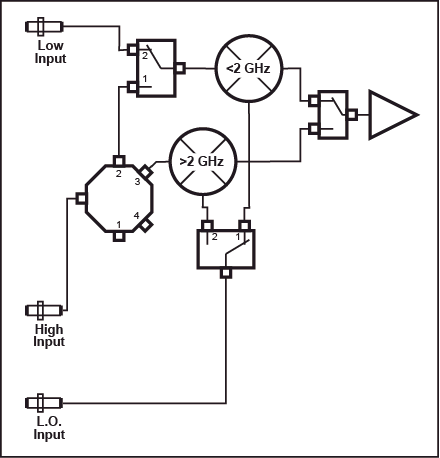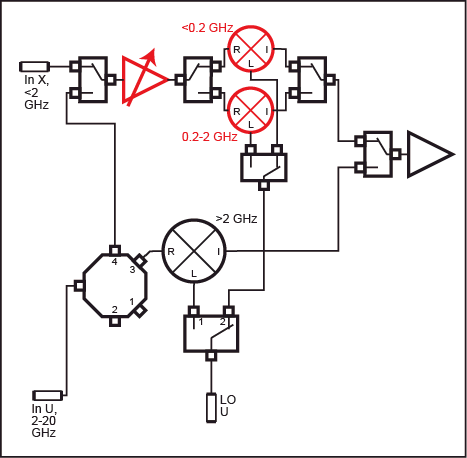As of January, 2008 we are shipping an improved receiver in the RI7100A testers. This receiver, designated the RI7323A, is the same for the high frequency input (RF2/3/6/7). However, for the low frequency input (RF4), additional circuitry provides more flexibility for the test engineer.
There are two changes:
1) A step attenuator and amplifier, shown as a variable amp in the block diagram, is added. This allows you to set attenuation for input power. The attenuation is 10 dB steps from 0 to 30 dB. The 10 dB step is the same gain as the old receivers, so the 0 dB step can be used to provide 10 dB more gain for additional sensitivity, and the 20 and 30 dB steps can provide more attenuation for higher-power signals.
The low-band attenuator defaults to 10 dB attenuation. This is the same gain as the old receiver, for maximum compatibility. However, for extremely low power measurements, the attenuator should be set to 0 dB for maximum sensitivity. For noise figure measurements, the attenuator MUST be set to 0 dB.
For most measurements, existing test plans will work with the new receiver. For noise figure measurements, test plans must be modified to add a button that sets the low-band attenuator to 0 dB.
Note that, once modified, the new test plan will work with old receivers. When compiling, the compiler will warn that the button has no function, but the test plan will function properly.
2) The range below 2 GHz now uses 2 mixers, one for frequencies below 220 MHz, and one for frequencies from 220 MHz to 2 GHz. This allows the tester to perform better at very low frequencies.
This change is transparent to the user. The tester automatically chooses the correct mixer based on the receive frequency. No changes need to be made to account for the additional mixer.
The only effect of the additional mixer is possibly better standard deviation on measurements below 10 MHz, depending on measurement and the setup of the tester.
Partial block diagram for old (RI7322x) receivers:

Partial block diagram for new (RI7323A) receivers, with the difference shown in red:

Note that Cassini testers all have the new receiver architecture.
These new receivers improve the flexibility of Roos testers and provide more tools for test engineers.

